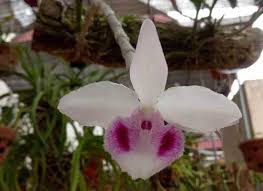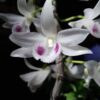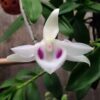# Techniques for Hybridizing Dendrobium Orchids to Create New Varieties
 Hybridization in orchids, especially with *Dendrobium nobile* (commonly known as *Phong Lan Phi Điệp*), is an intricate yet fascinating process that combines the beauty and traits of different parent plants to create unique new varieties. This practice is not only a significant part of the orchid hobbyist culture but also plays a vital role in the conservation and commercial aspects of the orchid industry. This article will explore the various techniques used in hybridizing Dendrobium orchids, the principles behind these techniques, the benefits of creating new varieties, and the challenges that hybridizers face in their pursuit of innovative and stunning new orchid hybrids.
Hybridization in orchids, especially with *Dendrobium nobile* (commonly known as *Phong Lan Phi Điệp*), is an intricate yet fascinating process that combines the beauty and traits of different parent plants to create unique new varieties. This practice is not only a significant part of the orchid hobbyist culture but also plays a vital role in the conservation and commercial aspects of the orchid industry. This article will explore the various techniques used in hybridizing Dendrobium orchids, the principles behind these techniques, the benefits of creating new varieties, and the challenges that hybridizers face in their pursuit of innovative and stunning new orchid hybrids.
## 1. Understanding Dendrobium Orchids
### 1.1 Overview of Dendrobium Orchids
Dendrobium orchids comprise one of the largest genera in the orchid family (Orchidaceae), with over 1,800 species. These orchids are primarily found in tropical and subtropical regions, particularly in Asia and the Pacific Islands. The genus is characterized by its diverse morphology, which includes a range of flower shapes, sizes, and colors. *Dendrobium nobile* is one of the most commonly cultivated species due to its vibrant flowers and relatively easy care requirements.
### 1.2 Importance of Hybridization
Hybridization is the process of cross-breeding two different species or varieties to produce offspring with desired traits from both parents. In the context of Dendrobium orchids, hybridization can result in:
– **Increased Resilience**: New hybrids may inherit traits that make them more resistant to diseases and environmental stresses.
– **Unique Aesthetics**: Hybridization allows for the creation of new colors, patterns, and forms, enhancing the aesthetic appeal of orchids.
– **Enhanced Growth Characteristics**: New hybrids may exhibit improved growth rates, flowering frequency, and overall vigor compared to their parent plants.
## 2. Basic Principles of Orchid Hybridization
### 2.1 Understanding Orchid Anatomy
To successfully hybridize Dendrobium orchids, it is crucial to understand their reproductive anatomy. Key components include:
– **Stamens**: The male reproductive part that produces pollen.
– **Pistil**: The female reproductive part that receives pollen and eventually develops into a seed pod after fertilization.
– **Pollinia**: The pollen mass of orchids, which is often transferred as a whole rather than individual pollen grains.
### 2.2 Methods of Hybridization
There are several methods for hybridizing Dendrobium orchids, including:
– **Natural Pollination**: This occurs when pollinators transfer pollen from the anther of one flower to the stigma of another. While this method can produce viable seeds, it is often unpredictable.
– **Hand Pollination**: A more controlled method where a hybridizer manually transfers pollinia from one flower to the stigma of another. This method increases the chances of successful fertilization and allows for specific crosses to be made.
– **Self-Pollination**: This involves transferring pollen from a flower to its own stigma. While this can produce seeds, it does not result in hybridization but rather self-fertilization.
### 2.3 Choosing Parent Plants
Selecting the right parent plants is critical in hybridization. Factors to consider include:
– **Traits**: Desired traits such as flower color, size, shape, fragrance, and growth habit should guide the selection of parent plants.
– **Compatibility**: Not all species or varieties of Dendrobium orchids are compatible for hybridization. Understanding genetic relationships and compatibility is essential for successful crosses.
– **Genetic Diversity**: To create robust hybrids, it is advisable to select parent plants from different genetic backgrounds to avoid inbreeding depression.
## 3. The Hybridization Process
### 3.1 Preparation for Hybridization
Before starting the hybridization process, preparation is essential:
– **Selecting Healthy Plants**: Choose parent plants that are healthy and disease-free to ensure the best chances of successful hybridization.
– **Timing**: Hybridization should be timed with the flowering period of the parent plants. Ensure that both plants are blooming simultaneously for effective pollination.
### 3.2 Performing Hand Pollination
#### Step 1: Collecting Pollinia
1. **Locate the Flower**: Identify a mature flower on the male parent plant.
2. **Remove the Anther Cap**: Using tweezers or a fine tool, gently lift the anther cap to expose the pollinia.
3. **Collect the Pollinia**: Carefully remove the pollinia, ensuring not to damage it.
#### Step 2: Pollinating the Female Parent
1. **Identify the Stigma**: Locate the stigma on the flower of the female parent plant.
2. **Transfer Pollinia**: Using the same tweezers or tool, place the pollinia onto the stigma. Ensure good contact to increase the chances of fertilization.
3. **Label the Cross**: It is essential to label the cross for future reference, noting the parent plants and date of pollination.
### 3.3 Caring for the Pollinated Flower
After successful pollination, care for the flower is crucial:
– **Avoid Disturbance**: Minimize handling of the flower to prevent stress or damage.
– **Monitor for Seed Pod Formation**: If fertilization is successful, a seed pod will develop. This process can take several months, depending on the species and environmental conditions.
## 4. Seed Pod Development and Harvesting
### 4.1 Seed Pod Maturation
The seed pod will undergo several stages of development:
– **Initial Growth**: After successful fertilization, the pod will swell as seeds develop inside.
– **Ripening**: Once fully mature, the pod will begin to dry out and turn brown.
### 4.2 Harvesting Seeds
1. **Timing**: Monitor the seed pod closely. It is typically ready for harvesting when it turns brown and begins to split.
2. **Collecting Seeds**: Carefully cut the pod open and collect the seeds, which are tiny and dust-like.
## 5. Germination of Orchid Seeds
### 5.1 The Unique Nature of Orchid Seeds
Orchid seeds are unique in that they lack sufficient nutrient reserves. They require a symbiotic relationship with specific fungi to germinate and develop properly.
### 5.2 Methods of Germination
There are two primary methods for germinating orchid seeds:
– **In Vitro Cultivation**: This laboratory-based method involves placing seeds in a sterile medium enriched with nutrients and growth hormones. This method provides a controlled environment for germination and reduces the risk of contamination.
– **Outdoors (Natural Conditions)**: While less common, some enthusiasts attempt to germinate seeds outdoors, relying on natural conditions and mycorrhizal fungi present in the soil. However, this method has a much lower success rate.
## 6. Growing Hybrid Seedlings
### 6.1 Care for Young Orchids
Once seeds have germinated, care for the young orchids is essential:
– **Light**: Provide bright, indirect light to encourage healthy growth. Avoid direct sunlight, which can scorch the delicate leaves.
– **Humidity**: Maintain high humidity levels to support the seedlings’ growth. This can be achieved through misting or placing humidity trays in the growing area.
– **Watering**: Use distilled or rainwater to water the seedlings. Avoid over-watering, which can lead to root rot.
### 6.2 Transplanting Seedlings
After several months of growth, the seedlings will require transplanting:
1. **Choose the Right Medium**: Use a well-draining orchid mix to provide support and aeration.
2. **Gently Remove Seedlings**: Carefully remove seedlings from their growing containers, taking care not to damage the roots.
3. **Transplanting**: Place each seedling in its own container, ensuring that the roots are covered with the medium while leaving the crown exposed.
## 7. Benefits of Creating New Dendrobium Hybrids
### 7.1 Enhancing Aesthetic Appeal
One of the most immediate benefits of hybridizing Dendrobium orchids is the creation of new and stunning flower forms, colors, and fragrances. Hybridizers can develop varieties that appeal to collectors and the general public, increasing the popularity of orchids.
### 7.2 Improving Plant Performance
New hybrids may exhibit enhanced characteristics, such as:
– **Greater Disease Resistance**: Breeding can lead to hybrids that are less susceptible to common orchid pests and diseases.
– **Longer Blooming Periods**: Selecting parent plants with longer flowering times can result in hybrids that provide extended blooms, enhancing their commercial value.
### 7.3 Conservation and Genetic Diversity
Creating new hybrids contributes to genetic diversity within the Dendrobium genus. This diversity is crucial for the overall health of the species, allowing for greater adaptability to changing environmental conditions.
## 8. Challenges in Hybridizing Dendrobium Orchids
### 8.1 Compatibility Issues
Not all Dendrobium species are compatible for hybridization. Determining which species can successfully cross-breed can be challenging and may require extensive knowledge of orchid genetics.
### 8.2 Time and Patience
The process of hybridization is lengthy, often taking years from initial pollination to the production of blooming hybrids. This timeline requires patience and dedication from hybridizers.
### 8.3 Market Saturation
As more hybrids are created, the market can become saturated with similar varieties, making it difficult for new hybrids to stand out. Hybridizers must continuously innovate to create unique and desirable plants.
## 9. Conclusion
The techniques used in hybridizing Dendrobium orchids, particularly *Phong Lan Phi Điệp*, are a blend of art and science, requiring a deep understanding of orchid biology, careful selection of parent plants, and
meticulous care throughout the process. As orchid enthusiasts and hybridizers continue to push the boundaries of creativity, the world of Dendrobium hybrids will keep evolving, offering new and breathtaking varieties for collectors and gardeners alike. The journey from pollination to blooming hybrid is not only rewarding but also plays a crucial role in the ongoing appreciation and conservation of these beautiful plants.
—
This article serves as a comprehensive guide to understanding the techniques and considerations involved in hybridizing Dendrobium orchids, focusing on the creation of new varieties through the hybridization process. Each step, from pollination to germination and growing seedlings, highlights the intricate nature of this fascinating horticultural practice.

